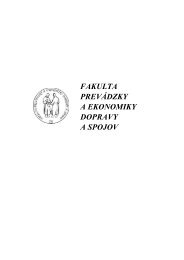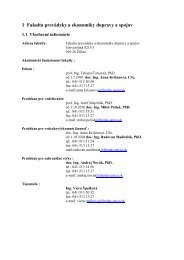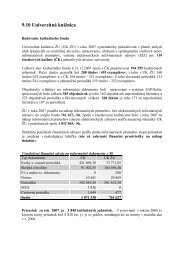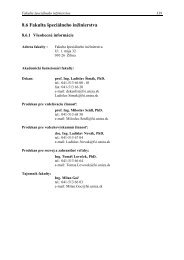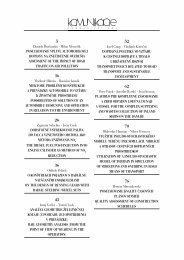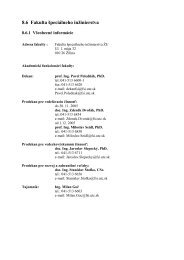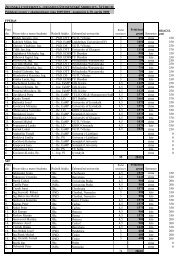n - Žilinská univerzita
n - Žilinská univerzita
n - Žilinská univerzita
You also want an ePaper? Increase the reach of your titles
YUMPU automatically turns print PDFs into web optimized ePapers that Google loves.
C O M M U N I C A T I O N S<br />
I S<br />
2. Matematický model<br />
2. Mathematical model<br />
Označme symbolom n počet obcí na sieti. Zo štatistických<br />
údajov je známy počet obyvateľov b j každej obce. Z údajov o cestnej<br />
sieti vypočítame maticu {d ij } vzdialeností každých dvoch obcí.<br />
Treba vytvoriť p p min , p max okrskov (pozostávajúcich z jednej<br />
alebo viacerých obcí) a pre každý okrsok S k , k 1, …, p určiť<br />
jednu zastupujúcu obec (ťažisko) i k tak, aby sa sieť zložená zo<br />
zastupujúcich obcí i k , k 1, …, p s agregovanými počtami obyvateľov<br />
a ik<br />
0<br />
b j čo najmenej líšila od pôvodnej siete. Predpokladajme,<br />
že sa minimalizovanú odlišnosť F siete zastupujúcich obcí<br />
jS k<br />
a pôvodnej siete podarí vyjadriť ako súčet nejakých ohodnotení F k<br />
jednotlivých okrskov. Nech navyše možno ohodnotenie F k uvažovaného<br />
okrsku S k vyjadriť ako súčet nejakých nezáporných ohodnotení<br />
c ik j vyjadrujúcich „mieru odlišnosti siete“, ktorú spôsobí<br />
zahrnutie obce j do okrsku S k so zastupujúcou obcou i k . Tým predpokladáme,<br />
že odlišnosť F sietí možno vyjadriť vzťahom<br />
F p<br />
F k p<br />
0<br />
c ik j .<br />
k1 k1 jS k<br />
Zavedieme bivalentné premenné y i {0, 1} vyjadrujúce, či<br />
obec i (ne)bude zastupujúcou obcou nejakého okrsku a premenné<br />
x ij {0, 1} vyjadrujúce, či obec j (ne)bude priradená zastupujúcej<br />
obci i. Potom môžeme úlohu vytvorenia okrskov vyjadriť pomocou<br />
modelu:<br />
minimize<br />
n<br />
n<br />
i1 j1<br />
Let n stay for a number of dwelling places in a network. The<br />
number b j of inhabitants is known for each place from statistical<br />
data. The data on a road network can be used to calculate the<br />
matrix {d ij }, which gives the distances between any two dwelling<br />
places. The goal of the district location will be to create p p min ,<br />
p max districts (consisting of one or several dwelling places) and to<br />
choose one representing place (center of gravity) i k for each district<br />
S k , k 1, …, p, so that the network composed of representing<br />
places i k , k 1, …, p with aggregated numbers of inhabitants<br />
a ik<br />
0<br />
b j will differ as little as possible from the original network.<br />
jS k<br />
Let us suppose that the difference F between the network of<br />
representing places and the original network, which is to be minimized,<br />
can be given as a sum of costs F k for all districts. Let<br />
further the cost F k for a district S k be defined as a sum of non-negative<br />
costs c ik j, which will correspond to an “extent of difference”,<br />
which will be caused by including a dwelling place j into a district<br />
S k with a representing place i k . The difference F among the networks<br />
can be then given by<br />
F p<br />
k1<br />
F k p<br />
k1<br />
0<br />
jS k<br />
c ik j<br />
Let bivalent variables y i {0, 1} define that a place i will or<br />
will not be a representing place of a district and variables x ij {0,<br />
1} define that dwelling place j will or will not be allocated to a representing<br />
place i. Then the following model can describe the<br />
problem of transportation districts location:<br />
c ij x ij (1)<br />
subject to<br />
n<br />
x ij 1 for j 1, …, n (2)<br />
i1<br />
x ij y i for i 1, …, n, j 1, …, n (3)<br />
n<br />
y i p max (4)<br />
i1<br />
n<br />
y i p min (5)<br />
i1<br />
x ij , y i {0, 1} for i 1, …, n, j 1, …, n (6)<br />
Túto úlohu prevedieme pomocou Lagrangeovej relaxácie na<br />
kapacitne neobmedzenú lokačnú úlohu, ktorú dokážeme riešiť<br />
exaktným algoritmom BBdual [3, 4] založeným na metóde vetiev<br />
a hraníc.<br />
Mieru odlišnosti siete sme vyjadrili pomocou siedmich modelov.<br />
Najjednoduchší model vyjadroval „posun“ požiadavky, tzn.<br />
minimalizovali sme vzdialenosti zrušených obcí ku zastupujúcim<br />
obciam, do ktorých sa presunú požiadavky na prepravu. Prijateľné<br />
riešenie dalo kritérium váženej vzdialenosti, kde vzdialenosť bola<br />
vynásobená počtom požiadaviek (počtom obyvateľov obce). V tomto<br />
prípade je c ij z modelu (1) – (6) definované vzťahom c ij b j d ij .<br />
The problem can be reformulated using Lagrangean relaxation<br />
on an uncapacitated location problem, which can be solved using<br />
exact algorithm BBdual [3, 4] based on the branch and bound<br />
approach.<br />
The extent of difference of a representing network against the<br />
original one was calculated according to seven different models.<br />
The simplest model expressed the “displacement” of a transportation<br />
demand, in other words, the distance of dwelling places to<br />
their representing places was to be minimized. A better acceptable<br />
solution was attained using a weighed distance, where the distance<br />
was multiplied by amount of a transportation demand in the<br />
6<br />
● KOMUNIKÁCIE / COMMUNICATIONS 1–2/2002



